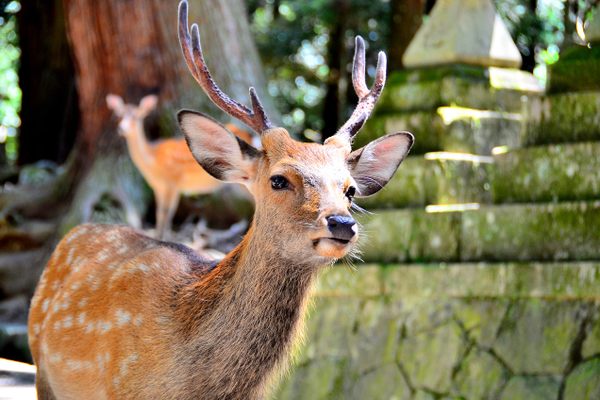Why a Wayward Coati’s Selfie on a Brazilian Airbase Surprised Scientists
The adorable appearance highlights an unexpected ally in conservation.
The camera trap footage is silent, and lasts just a few seconds. In the background, morning light filters through to the forest understory. The animal who has triggered the camera pauses to sniff the air, its tapered snout bobbing a few times. It is August in southern Brazil, and the air is thick with the earthy-sweet smell of last season’s leaves turning to dirt. A nearby stream courses with runoff from a recent rain. Perhaps the animal caught a whiff of something else: a blend of exhaust and asphalt, concrete and plastic, found wherever large numbers of humans settle tightly together.
Whatever the animal detected on the morning air, it seems unperturbed. It steps over the slender trunk of a fallen tree and ambles off camera, unaware it just made history.
The brief scene, captured as part of a biodiversity study at Canoas Airbase, is the first sighting of a South American coati (Nasua nasua) in the urban heart of Canoas, one of the most densely populated cities in Rio Grande do Sul, Brazil’s southernmost state. While the South American coati is widespread across much of the continent, its population has tumbled in recent decades in some areas, particularly in Brazil’s deep south, where habitat destruction and fragmentation have taken their toll.
“It was a surprise for me and my team,” says biologist Diego Floriano da Rocha, lead author of a recent paper, published in Neotropical Biology and Conservation, that details the sighting. “The South American coati is not seen in large cities such as Canoas, here in the state of Rio Grande do Sul, the only Brazilian state in which the species is threatened.”
Perhaps even more surprising, the coati’s camera-trap selfie was taken not on the outskirts of crowded Canoas, but near its concrete and asphalt heart. According to the paper, 99.86 percent of the municipality is urbanized; one of the few green areas left within the city limits is an active airbase of just over 2,000 acres. The base is hemmed in by busy highways, an industrial district to the east and urban sprawl in every direction. Despite its surroundings, the area can be an oasis of wilderness.

“Depending on the spot you are in, inside the base, you cannot hear the city noise,” says coauthor Ana Maciel, the base biologist. “We have wetlands, grasslands, so this kind of diversity provides different resources to the wildlife here.”
The adorable animal that made a brief appearance on the Canoas camera trap resembles a cross between a ring-tailed lemur and an opossum, but coatis are in the same family as raccoons. They’re omnivores as comfortable in the trees as they are on the ground, and, much like raccoons, use their nimble front paws to get into any space their curiosity takes them.
Adult coatis weigh around 10 pounds, and are not particularly territorial; home turf for different bands—groups of females and their young—often overlap, with solitary males ranging between them. While Maciel thinks there may be a local population, the paper’s senior author, La Salle University (Canoas) professor Cristina Cademartori, believes the solitary sighting is more likely to be a lone male, just passing through.
“Camera traps were kept in the area for five months, every day, and we couldn’t get another record, so I don’t think it is evidence of an established family group at the airbase,” she says. If it was a single male just exploring, the coati seemed to like what he found. “We can see in the video that the animal is calm, moving slowly, and exploring the environment. He’s not running away, and looks healthy.”
Despite making only one guest appearance, the coati’s documented presence at the airbase is significant, says Texas Tech University conservation biologist Gad Perry, who was not involved in the Canoas study.
“Scientists like large amounts of data,” says Perry. “But single events like this can … set the stage for more comprehensive efforts when they indicate something interesting and unexpected is happening.”
In his research, Perry focuses on human impacts on the environment, including urban ecosystems. He’s familiar with coati from fieldwork in Costa Rica, and has also seen them in a somewhat less-wild setting in Brazil: While visiting Foz do Iguaçu, a city near the famous Iguaçu Falls, he remembers watching coati “wander around visitors and raid trash cans for food.” In fact, Perry is not that surprised a coati would turn up in the heart of Canoas—the dumpster-diving proclivity that they share with their raccoon relatives, among other traits, makes them adaptable to urban environments.
Cademartori says that, in Rio Grande do Sul’s cities, the coati is considered “a cute wild animal,” but one seen only in zoos. Being able to document even just one coati roaming the metropolis may help raise awareness about the need to keep green spaces available for the benefit of wildlife—and humans.

With most people now living in cities worldwide, “urban wildlife interactions may be their only wildlife interactions,” says Perry. “Having nature around us, even if it is a city park or a visiting fox, is good for human well-being, physical and mental. Such exposure is also good for support of conservation actions.”
The lone coati is not the only wild animal to have found the airbase appealing. Cademartori ticks down a long list of other mammals spotted on camera traps set up at 22 locations, including capybara, a lesser grison, which is related to weasels and martens, and a southern tiger cat (Leopardus guttulus), a rare species that was not formally identified until 2013. “The wildcat really surprised us, too,” says Cademartori.
For Maciel, whose work focuses on wildlife hazard management, particularly reducing the risk of bird-aircraft collisions, the coati video and other animal sightings in the study highlight a benefit of military installations that typically goes unnoticed. With restricted human access and often large, undeveloped areas, bases can offer a refuge, even without being officially designated as such—even, Maciel notes, for “those animals that we didn’t even know could be there.”



































Follow us on Twitter to get the latest on the world's hidden wonders.
Like us on Facebook to get the latest on the world's hidden wonders.
Follow us on Twitter Like us on Facebook